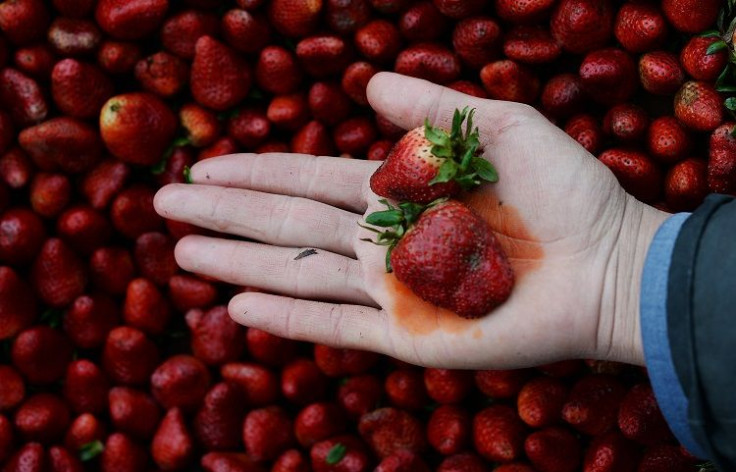Strawberries Rate Worst In 'Dirty Dozen' List Of Fruits And Vegetables With Most Pesticides

Strawberries are a beloved fruit, eaten by the truckloads in America. But biters beware; according to a new report, along with every bite comes a little dose of pesticide residue. The annual “Dirty Dozen” list, released by the Environmental Working Group (EWG), revealed that strawberries earned the top spot as this year’s biggest pesticide carriers. Apples, which have taken first place for the last five years, came in second, followed by nectarines, and peaches.
Each fruit and vegetable was tested by the U.S. Department of Agriculture (USDA) for a number of different types of pesticides. It turns out, more than 98 percent of the samples of strawberries, peaches, nectarines, and apples tested had at least one type of pesticide residue. One single sample of strawberries contained 17 different pesticides.
Accompanying the list of the worst, EWG released a list of the cleanest produce, or those with the least amount of detectable pesticides on them. The list can provide produce shoppers with peace of mind that these particular fruits or vegetable s are least likely to hold pesticide residue, and therefore the safest to consume. Avocados, for example, were by far the cleanest. Only one percent of avocado samples showed any trace of detectable pesticides, while 11 percent of pineapples contained a detectable level of pesticides, followed by 22 percent of mangoes, and 27 percent of kiwi.
Instead of cutting the dirty dozen fruits and vegetables out of your diet, you have options. Those who want to avoid pesticides in their fruits and vegetables may want to turn to the organic produce aisle for solace. Fruits or vegetables labeled organic have been produced through USDA-approved methods that limit certain levels of pesticides found to be prevalent throughout the dirty dozen. The fruits and vegetables that have been included in this list are believed to be most susceptible to pesticides because their soft and permeable skin tends to absorb the chemicals more readily. In comparison, produce that aren’t included on the list tend to have thicker skin that protects the edible part of the fruit or vegetable.
According to the Centers for Disease Control and Prevention, the average American can trace 29 different pesticides within their body from consumption or other exposure, and Dr. Michael Crupain, the director of Consumer Reports’ Food and Safety Sustainability Center, says we shouldn’t be too worried.
“We’re exposed to a cocktail of chemicals from our food on a daily basis,” Crupain said. “It’s not realistic to expect we wouldn’t have any pesticides in our bodies in this day and age, but that would be the ideal,” says Crupain. “We just don’t know enough about the health effects.”
In order to see for yourself what foods in your fridge are the most likely to contain pesticides, review the EWG’s best and worst offenders list. Just keep in mind that these low-level pesticides aren’t known to pose a health risk to consumers. According to the USDA, a little pesticide residue shouldn’t keep anyone from consuming their daily recommended servings of fruits and vegetables.
Dirty Dozen
- Strawberries
- Apples
- Nectarines
- Peaches
- Celery
- Grapes
- Cherries
- Spinach
- Tomatoes
- Sweet bell peppers
- Cherry tomatoes
- Cucumbers
Clean Fifteen
- Avocados
- Sweet Corn
- Pineapples
- Cabbage
- Sweet Peas Frozen
- Onions
- Asparagus
- Mangos
- Papayas
- Kiwi
- Eggplant
- Honeydew Melon
- Grapefruit
- Cantaloupe
- Cauliflower



























